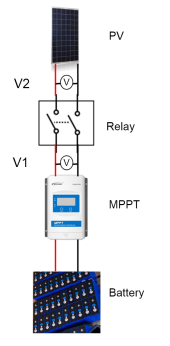One concern I have with the above "Fail Safe" circuit is that once it energizes the relays, it puts a brief load on the battery which brings the battery voltage back in line, and the relay reconnects the PV panel. It will continue to cycle like this, keeping the battery from overcharging, but I think the cycling of the relay(s) and PV panels may be too frequent.
What I think might be better is to have the "Fail Safe" short out the PV panel and simultaneously trigger a visual and audible alarm for any over voltage condition. Once the fail safe is triggered it should remain triggered, with all PV panel charging halted and the alarm continuing to sound until manually reset with a switch. Keep in mind that the only reason the Fail Safe has tripped is if some other piece of equipment has already failed. I think it's probably better to trigger an alarm and have the charging halted, so the system gets checked out for the fault, rather than cycle the relays and PV panels excessively.
Each relay now only draws about 20 milliamps (due to a change in the circuit design), and the LED and piezo buzzer add just a few more milliamps. With a fully charged battery, the alarm could sound for days, if necessary, depending on other battery loads.
A second concern I had was regarding contact arcing that may occur when the relay shorts out the PV panel. I've been working on the circuit design and think I can short out the PV panel with an SCR instead of with relay contacts. This should eliminate any concern to the solar charge controller inputs caused by contact arcing. It also lowers the fails safe's current draw to less the a tenth of an amp while sounding the alarms and interrupting the PV panel charging. Monitoring alone will be just a couple of milliamps. Kind of a win, win, if it tests out okay.
Since the vast majority of the time the Fail Safe is only monitoring, I thought I'd also include a "Test" button. Just a momentary switch to trigger an overvoltage simulation to the comparator and trigger the alarm. Kind of a like how a smoke detector is tested, only the Fail Safe would require a manual reset to stop its alarm.
What I think might be better is to have the "Fail Safe" short out the PV panel and simultaneously trigger a visual and audible alarm for any over voltage condition. Once the fail safe is triggered it should remain triggered, with all PV panel charging halted and the alarm continuing to sound until manually reset with a switch. Keep in mind that the only reason the Fail Safe has tripped is if some other piece of equipment has already failed. I think it's probably better to trigger an alarm and have the charging halted, so the system gets checked out for the fault, rather than cycle the relays and PV panels excessively.
Each relay now only draws about 20 milliamps (due to a change in the circuit design), and the LED and piezo buzzer add just a few more milliamps. With a fully charged battery, the alarm could sound for days, if necessary, depending on other battery loads.
A second concern I had was regarding contact arcing that may occur when the relay shorts out the PV panel. I've been working on the circuit design and think I can short out the PV panel with an SCR instead of with relay contacts. This should eliminate any concern to the solar charge controller inputs caused by contact arcing. It also lowers the fails safe's current draw to less the a tenth of an amp while sounding the alarms and interrupting the PV panel charging. Monitoring alone will be just a couple of milliamps. Kind of a win, win, if it tests out okay.
Since the vast majority of the time the Fail Safe is only monitoring, I thought I'd also include a "Test" button. Just a momentary switch to trigger an overvoltage simulation to the comparator and trigger the alarm. Kind of a like how a smoke detector is tested, only the Fail Safe would require a manual reset to stop its alarm.
Last edited:



